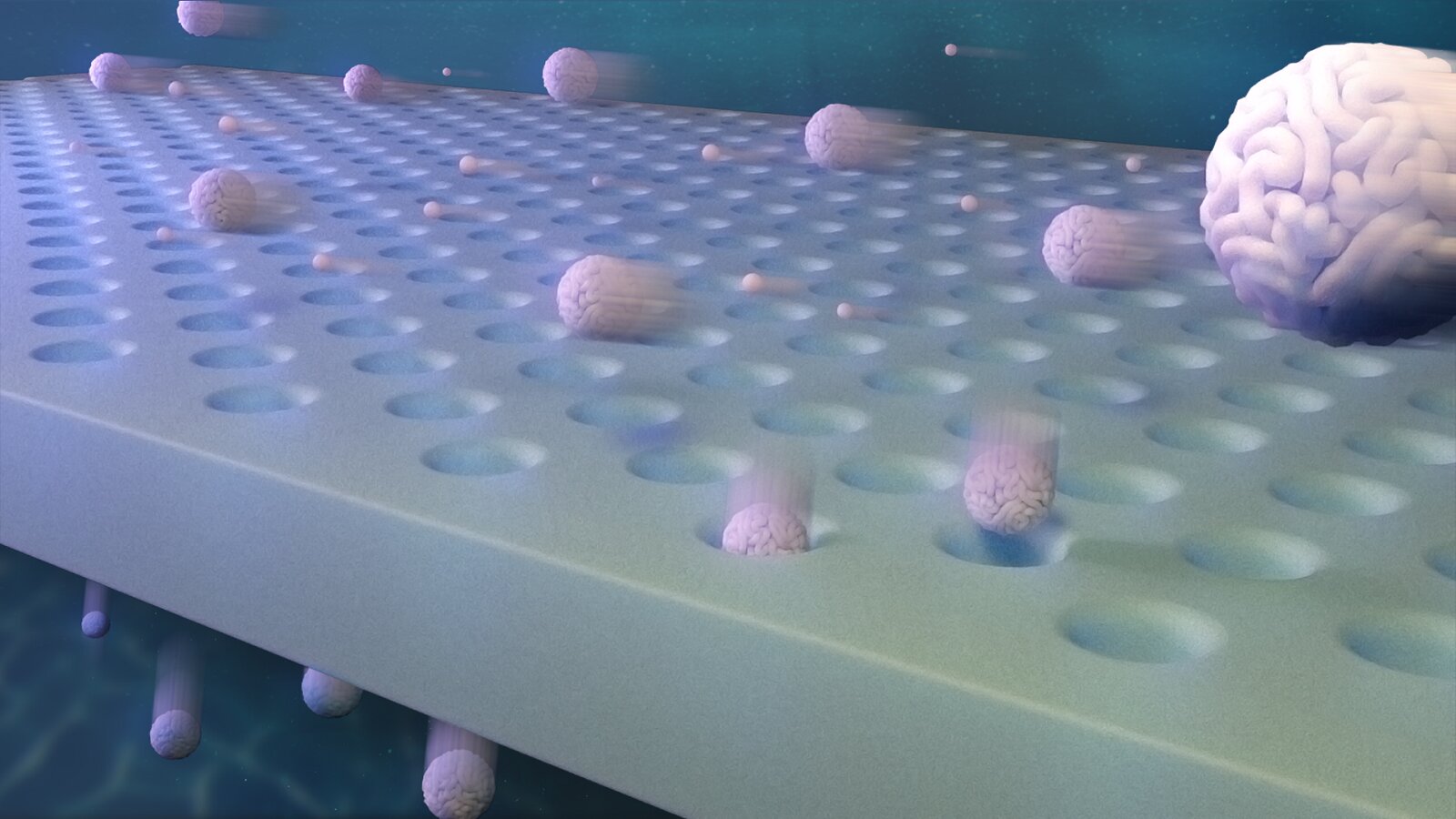
Nanoscale solutions with small size differences can be separated by membranes with identical pores—if they have enough opportunity to try. Credit: Argonne National Laboratory.
Imagine a close basketball game that comes down to the last shot. The probability of the ball going through the ring may be quite low, but it would increase dramatically if the player was given the opportunity to shoot it over and over again.
A similar idea is at play in the scientific field of membrane separations, a key process at the heart of industries spanning everything from biotechnology to petrochemicals to water treatment to food and beverage.
“Separations lie at the heart of so many products we use in our daily lives,” said Seth Darling, head of the Center for Advanced Materials for Water-Energy Systems (AMEWS) at the US Department of Energy’s Argonne National Laboratory. (DOE). “Membranes are the key to achieving efficient separations.”
Many commercial processes use membranes to separate solutes into different sizes, which are substances that dissolve in water or other liquids. Almost all commercial membranes are polydisperse, meaning their pore sizes are not consistent. For these membranes, it is almost impossible to make a sharp separation of materials since different sizes of solutes can enter through different pores.
“Basically all commercial membranes, all membranes that are actually used for anything, have a wide range of pore sizes — small pores, medium pores and large pores,” Darling said.
Darling and his colleagues at Argonne and the Pritzker School of Molecular Engineering at the University of Chicago have been interested in looking at the properties of isoporous membranes, which are membranes in which all the pores are the same size.
Previously, scientists had believed there was a limit to the sharpness of the separations they could achieve at the nanoscale, not only because of variations in pore size, but also because of a phenomenon called “impeded transport.”
Impeded transport refers to the internal resistance of the liquid medium as the solute tries to pass through the pores.
“The water in the pore will create drag on a molecule or particle that’s trying to break through, causing it to slow down,” Darling said.
“Those slower solutes seem to be rejected by the membrane. Counterintuitively, objects even half the pore size will end up being rejected about half the time.” Overcoming the rejection created by hindered transport would enable unprecedented selectivity in size-based separations, he explained.
“The regime we are interested in involves pores around 10 nanometers in diameter. With a perfect membrane and proper process design, we believe we can separate solutes with a 5% difference in size. Current membranes do not have no chance to pull it off,” said the girlfriend.
In a new study, Darling and his colleagues discovered a dynamic that could only be discovered by studying isoporous membranes and that offers hope for overcoming hindered transport limitations. A paper based on the study appears in the June 20 online edition Nature’s water.
“Until now, scientists had implicitly assumed that each solute required only one effort to pass through a pore, and that hindered transport would produce the rejection of many solutes that were smaller than the pore size, causing them to remain in the feed stream rather than the output stream,” Darling added.
“Although it may seem obvious to some, people never considered a situation in which solutes could make multiple attempts to cross a membrane.”
To give the solute molecules multiple chances to pass through the pores, cycling the nutrient solution for several weeks is required.
“Even with an extended period of experimentation, we’re still only seeing individual solutes trying to cross a pore a few times on average, but that makes a big difference in moving the partition curve toward a sharper function like open.” Said the girlfriend.
“Given longer times, or more likely an improved process design, we believe we will see a clear, sharp separation right where the pore size matches the solution size.”
Insights learned from isoporous membranes can be applied to existing membrane materials designed to increase the number of opportunities for solutes to pass through the pores.
“If these fundamental studies can be successfully transferred to industrial membrane separations, it could have a tremendous impact on many sectors of our economy,” he said.
More information:
Pushing the limits of size selectivity in nanoscale solute separations, Nature’s water (2024). DOI: 10.1038/s44221-024-00252-3. www.nature.com/articles/s44221-024-00252-3
Provided by Argonne National Laboratory
citation: Scientists discover new membrane behavior that could lead to unprecedented separations (2024, June 21) retrieved June 23, 2024 from https://phys.org/news/2024-06-scientists-behavior-membranes-unprecedented. html
This document is subject to copyright. Except for any fair agreement for study or private research purposes, no part may be reproduced without written permission. The content is provided for informational purposes only.
